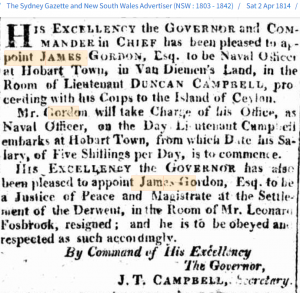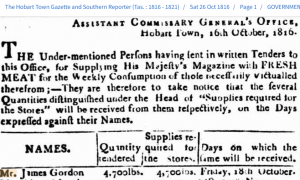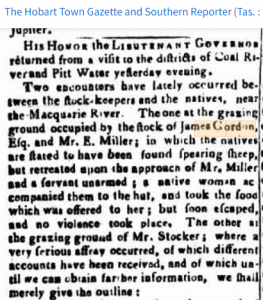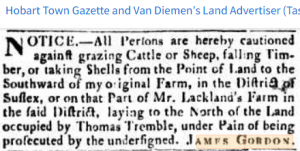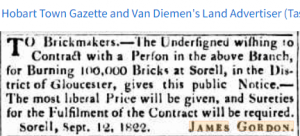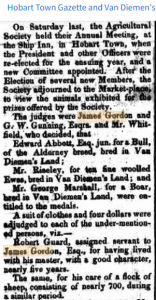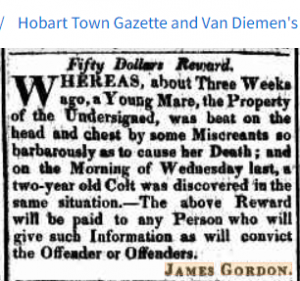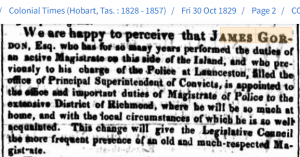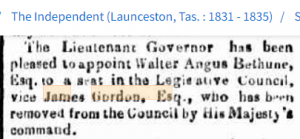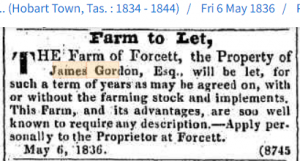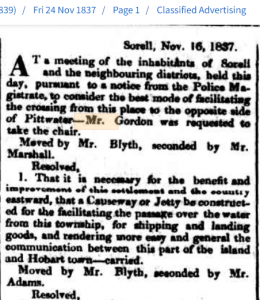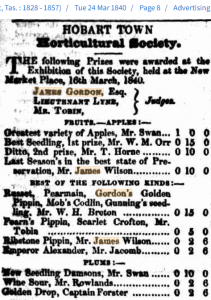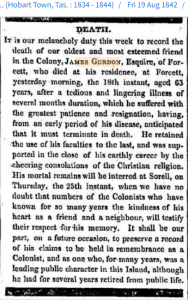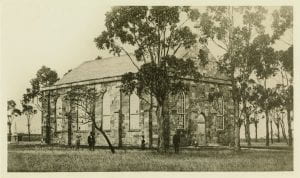Thanks to Judy Pearson (nee Dodge) for writing this post for the A-Z challenge.
Blue links will take you to the digitized images from Libraries Tasmania website. Clicking on image in post will take you to the original at Tasmanian Archive and Heritage Office (TAHO).
The McGinnis (McGeniss McGuinness) family of The Carlton began their lives in Van Diemens Land at Clarence Plains having been part of the exodus from Norfolk Island when that early convict settlement was closed down by the authorities in 1807/08. The promise of land equal to 4 times that which they had left was not properly fulfilled when they arrived at the struggling settlement in Hobart Town. Many of these new arrivals were in time located in Clarence Plains on small plots of land. One of these families was Hugh McGinnis’s with his partner Charlotte Simpson/Hall who had until 1795 been partner of William Dodge, Superintendent of Convicts on Norfolk Island, and her living children Ralph and Sarah Dodge). Hugh and Charlotte had another 5 children all born on Norfolk Island, Hugh Jnr., Rebecca, Andrew, John Hall, William Daniel Simpson, and Elizabeth. Sarah Dodge was baptised Sarah McGinnis in Hobart Town where Hugh and Charlotte were married in 1810.
Within a few years the whole family chose to move on to more suitable and fertile land and Hugh, his 3 sons and step-son Ralph Dodge all received grants at The Carlton where they became farmers and significant pioneers of a settlement near Chaseys Creek. They increased their holdings in the area, Ralph Dodge having more land further to the north and from there he operated a packhorse mail run, and in 1841 he established the Carlton Post Office and was the first Postmaster. This served the community until 1949 with many family members working as Postmaster, including John Hall McGinnis.
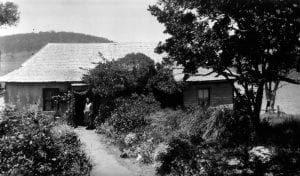
TAHO, NS1029/1/129
Hugh McGinnis farmed his land but owned a schooner and a whale boat at Marion Bay. He pioneered the work of the Congregational Church in the district and prayer meetings were held in his home. He died in 1841 and is buried at St. Davids, Hobart.
John Hall McGinnis married Mary Smith in 1822. In 1837 he owned several properties and donated land for the Carlton Congregational Church, burial ground, school and playground. He was a lay reader and superintendent of the Sunday School for considerable years. The Chapel has a long history and on the 180th anniversary of the first Public Worship held there on 10th January 1841 the owners held a celebratory High Tea on their recently acquired property. John McGinnis also owned and was licensee of the Carlton Inn and Store (also known as the Prospect Inn).
His brother Hugh took over the license when John died in 1854 and changed the name to Carlton Arms. Hugh McGinnis Jnr. married Elizabeth Thomas. In 1828 he became a Division Constable. He was recorded as a Publican and owned land in a number of other areas. He died at his home ‘Bay View’ Carlton in 1884 and is buried in the Chapel Churchyard in McGuinness Road.
The Carlton River Cemetery is at the top of McGuinness Rd. and is accessible to the public but there are few headstones still showing. None show the name McGinnis (McGuinness) but relatives would have been buried there and many descendants still live throughout the area.
Kath Lonergan has written the story of the McGuinness family at Carlton in her book entitled ‘Kindred Connections’. She is a descendant of both Dodge and McGuinness families.

